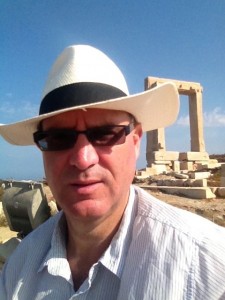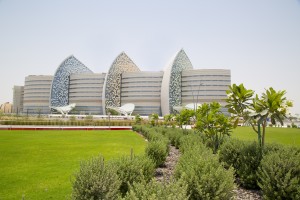 We were able to catch up with Dr. Patrick Sheehan during one of the few moments that he is not researching the genetic basis for a number of ENT conditions that affect Middle Eastern children, founding a clinic for children with Down syndrome, lecturing or – most recently – developing a world class pediatric otolaryngological service for the children of Qatar at Sidra Medical and Research Center
We were able to catch up with Dr. Patrick Sheehan during one of the few moments that he is not researching the genetic basis for a number of ENT conditions that affect Middle Eastern children, founding a clinic for children with Down syndrome, lecturing or – most recently – developing a world class pediatric otolaryngological service for the children of Qatar at Sidra Medical and Research Center
Dr. Sheehan, Division Chief of Pediatric Otolaryngology at Sidra, was one of the first "pioneers" to enroll the Medical and Research Center in the Global Tracheostomy Collaborative (GTC) as a hospital member in early 2014. Sidra is located in Doha, Qatar; in the Middle East North Africa (MENA) region.
GTC: Dr. Sheehan. Thank you for taking the time to speak with us. When did you first become interested in Tracheostomy Care?
Dr. S: Interestingly, I can remember the first patient that got me interested in tracheostomy care. Within weeks of being appointed a consultant in 2000 at Manchester Children's Hospital - Booth Hall (one of the oldest dedicated children’s hospitals in the UK), I saw a child aged about 7 who had a tracheostomy fitted as a baby. I think for a subglottic hemangioma. Declan had been coming back to ENT for yearly reviews but nobody had asked why the child needed to continue with a tracheostomy. After the consultation, I suggested to the parents that we should evaluate the need for continuing without the tracheostomy. I suggested a direct laryngoscopy, and that we move forward from there. After the direct laryngoscopy I advised the parents that as far as I could see there was a good airway and we should consider a trial of decannulation. There was a real reluctance ─“Who was this new ‘young’ consultant who was advocating such a radical move?” I really did have to move forward very slowly but ultimately I was able to decannulate the child within three months. On the visit after decannulation, I had a delighted child who was talking confidently and, more importantly, parents who informed me that the decannulation has changed their outlook for the future. They told me that that they always had a desire to buy a sheep farm in the Outer Hebrides, a small group of isolated islands north of Scotland in the North Sea, but could never consider it because of Declan’s tracheostomy and his need to be near a medical center. As a result of the decannulation, they were able to revisit their dream! A few months later I received a lovely letter thanking me for all I had done for Declan and a photo of the farm they had bought in the Outer Hebrides. I felt good that I had made such a difference already in my new role. I continued that year decannulating several other patients who seemed to have gotten “lost” in the system. I identified the need to have a database of children that had tracheostomies undertaken and the need for patient care plans, reviewed regularly for as long as the tracheostomy was in situ.
GTC: Please tell us about the new hospital that you are joining; does it have a special mission?
Dr. S: Wow. What a project and what an opportunity we have here at Sidra Medical and Research Center. We are helping to commission a state of the art, world class pediatric and women’s hospital for the state of Qatar. Sidra will initially have around 400 beds with infrastructure to enable expansion to 550 beds in the subsequent phase. Sidra will also be a referral center for children from across the Middle East region and further afield. It will be the first hospital with innovative systems integrated into its design from inception.
 The hospital has a US$7.9 billion endowment from the Qatar Foundation for Education, Science and Community Development (QF), one of the largest endowments of its kind in the world. It is chaired by Her Highness Sheikha Moza bint Nasser. Sheikha Moza plays a key role in supporting the country’s National Vision – a far-reaching agenda to transform Qatar into a thriving, knowledge-based society by 2030.
The hospital has a US$7.9 billion endowment from the Qatar Foundation for Education, Science and Community Development (QF), one of the largest endowments of its kind in the world. It is chaired by Her Highness Sheikha Moza bint Nasser. Sheikha Moza plays a key role in supporting the country’s National Vision – a far-reaching agenda to transform Qatar into a thriving, knowledge-based society by 2030.
As a primary teaching partner for Weill Cornell Medical College in Qatar, Sidra physicians and simulation specialists are currently training medical students to develop their clinical skills in line with Qatar’s National Vision to make today’s students become tomorrow’s innovators.
As clinical staff, we are currently here setting up the services, based on a strong vision of holistic, patient-centered care. We are mandated to commission the hospital with the best equipment and personnel and provide world class treatment to the children and women of Qatar. Our mission is to provide the best in treatment, but also education and research.
 We have leaders in all disciplines from across the world. It is fantastic to work with some of the best people from North America, Europe, the Middle East, Asia and Australasia. To learn from people who have worked in the biggest centers – Boston Children, The Children's Hospital of Philadelphia, the Great Ormond Street Hospital (GOSH), Starship – Auckland, and Sydney and Melbourne Children’s Hospitals. I tell you it’s the best experience one could ask for.
We have leaders in all disciplines from across the world. It is fantastic to work with some of the best people from North America, Europe, the Middle East, Asia and Australasia. To learn from people who have worked in the biggest centers – Boston Children, The Children's Hospital of Philadelphia, the Great Ormond Street Hospital (GOSH), Starship – Auckland, and Sydney and Melbourne Children’s Hospitals. I tell you it’s the best experience one could ask for.
It is a real honour and privilege to be part of this project and to head up the Pediatric Otolaryngology Department. I have already started our tracheostomy care MDT with multinational members; a respiratory physician from the UAE, tracheostomy clinical nurse leaders from New Zealand, Australasia and GOSH, a respiratory therapist from Australia, a speech and language pathologist from Egypt, and so on. We are buzzing with excitement and can’t wait to get active in the new hospital.
GTC: How did you hear about the GTC?
Dr. S: I was at the European Society of Pediatric Otolaryngology meeting in Dublin last April when I listened to a passionate presentation on the GTC by my colleague Neil Bateman. Having just put together the tracheostomy care MDT, I knew immediately that we needed to join this collaborative and that I should bring the GTC to the Middle East. In keeping with the spirit of Sidra and the strive for patient focus and clinical excellence, my Department was fully supportive of the GTC. Our journey has thus started and we hope that Sidra will be able to host a kick-off meeting in the near future.
GTC: I know you are a risk taker with all your previous "start-ups" so you understand the work and risk that goes into making a dream into reality. Most institutions/companies would be reluctant to join a collaboration or start-up that does not have "proof of concept" ~ but not you! What about the GTC appealed most to you to make you forego all conventional collaborative(s) to join our fledgling company?
Dr. S: When one is passionate about a project and instinctively knows that the project is the way forward, the mission is easy. In my previous start-ups I knew I was doing the right thing and worked with my sights fixed on the goal. There were setbacks, but I always found a way around obstacles because I knew I had to get the mission completed. Sometimes it meant bartering but I maintained the determination to move forward. I am similarly passionate about the mission and vision of the GTC and will work with determination to promote the Collaborative here in the region. I truly believe the GTC initiative is one of the best patient safety projects to improve the lives of children that we otolaryngologists can be involved in. I am so pleased that the tracheostomy care MDT that I assembled is as passionate about the project as I am. With such a multi-national team here at Sidra, we are fortunate that we will be able bring such a global input to patient tracheostomy care.
GTC: What do you feel is going to be the greatest benefit of joining the GTC and what will be the greatest hurdle for your new hospital? How do you suggest overcoming those hurdles?
Dr. S: The greatest benefit will be having access to the resources from around the world that the GTC website offers. We will be able to tailor these resources to our particular fit here in the Middle East and I’m sure we will be inspired to develop some strategies that we find will suit our local medical care environment. So far we have found the webinars in particular a really helpful resource, particularly when we gathered and watched the webinar as a team. So far we have not had any hurdles, but we can see there will be challenges to manage. For instance, we see that our discharge planning of a child with a tracheostomy will have to be considered carefully as there are no real primary care home facilities here in Qatar. However, these are being developed and we see that we can be involved early on in advising on best practice care.
Personally, the biggest challenge I have set myself is to persuade other hospitals in the region to follow the initiative that Sidra has taken and join the GTC as soon as possible. I am hoping that when others see a new hospital like Sidra has set its sights on evidence-based best practice and has already joined the GTC, then others will follow. I have already delivered a number of presentations at regional conferences to highlight the GTC and encourage institutions and departments to join. If I can get others to join then I will feel that this start-up project of mine is another success.
GTC: Why was it such a priority to enroll that you joined prior to even starting to see patients?
Dr. S: I saw a unique opportunity to get our tracheostomy care MDT to the highest level of practice, before we start to see patients. So many teams in other institutions are hampered by set and ingrained practices and problems, such that they struggle to make changes. Here, we were blessed with a “blank piece of paper” so to speak; we have an opportunity to develop a tracheostomy team “from scratch”. We are designing a service that is a fusion of best practices from around the world.
GTC: What challenges do you see in the future concerning trachs and how do you feel that the data gathered by the GTC will be beneficial to institutions?
Dr. S: History has shown that tracheostomies are one of the oldest procedures performed by physicians and I have no doubt that they will be around for a long time to come. Technology has enabled us to pass on our best practices from around the world and they can be disseminated and accessed more easily than ever before. With this advantage comes responsibility; it is imperative that we to do our best for our patients and the GTC is a tool that enables us to do so. The database will soon highlight practices that provide better outcomes for our patients, which we can then implement. It will also show any practices that are not working and need changing. It is then the duty of all institutions to change these practices for the better. We all know that if we benchmark ourselves against others our outcomes always improve.
GTC: Dr. Sheehan. Thanks again for your time, your dedication to the tracheostomy community and your support of the GTC. Do you have any last words of wisdom that you would like to give to our audience?
Dr. S: We are the pioneers of this new initiative to promote best practices in tracheostomy care. All of us who are already part of the GTC are passionate about this project so our goals are now not only to improve tracheostomy care in our own institutions, but just as importantly to encourage others to join our mission.
We have to take so much encouragement from Dr David Roberson, who started this initiative. Now that is a man with a big vision. We all have a duty to promulgate that vision.
When we hand over the care of tracheostomy patients to the next generation of caregivers, the idea of a preventable adverse event should be as alien to them as not giving a polio vaccine to a child in this day and age.
I am now part of two legacies that I look forward to seeing flourish: Sidra Medical and Research Center in Doha, Qatar and the Global Tracheostomy Collaborative. I shall retire a happy man if both are a success.
If you have questions that you would like to direct specifically to Dr. Sheehan, please post your questions/comments on the member hospital forum. For those that are not yet members, please email us.
We encourage everyone that is a member, healthcare professional or family/patient member to visit your assigned forum - build community, relations with each other and help the GTC to educate and change the way the world takes care of trach patients.

